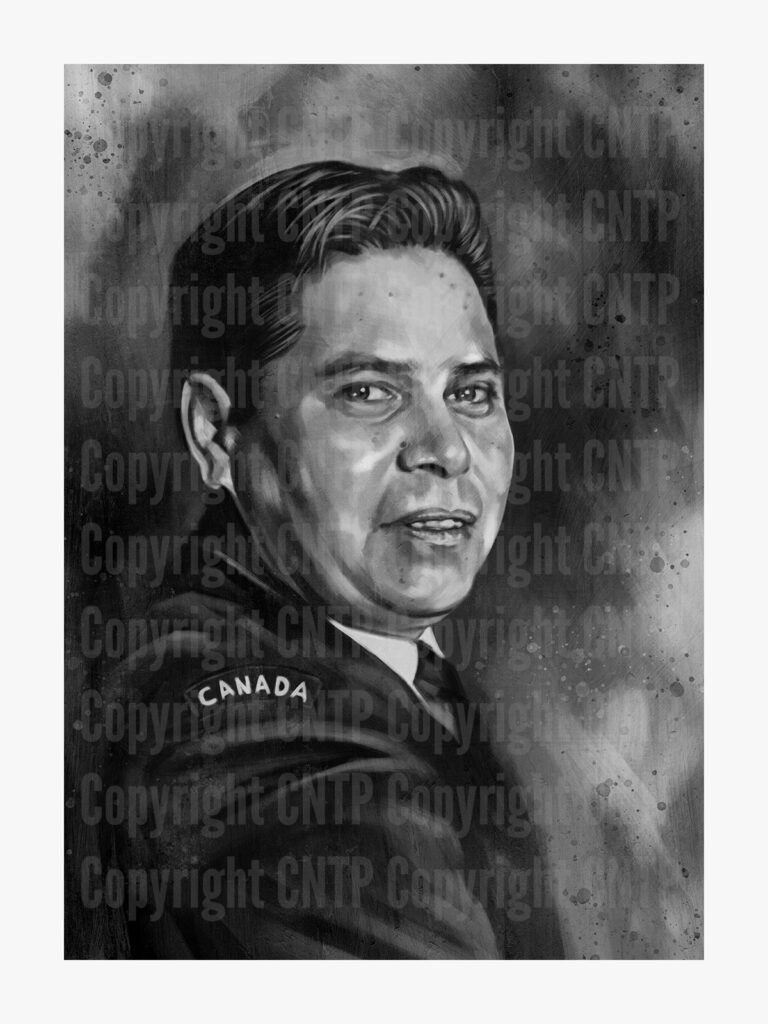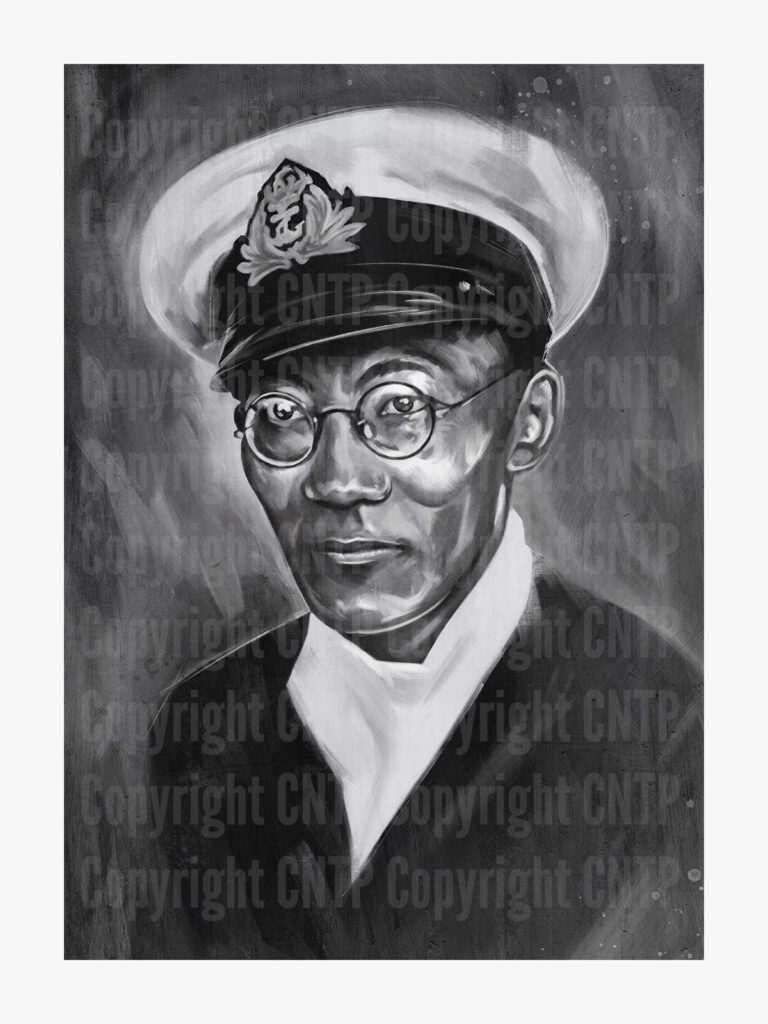“Toronto-born member of the Six Nations Upper Cayuga Band Served in both the Second World War and Korean War”
George Edward “Ted” Jamieson was born in Toronto in 1922, a member of the Six Nations Upper Cayuga band. He joined the Sea Cadets in his early teens and then, despite being underage, persuaded his recruiter and enrolled in the Royal Canadian Naval Volunteer Reserves (RCNVR) as a bugler. When Canada declared war on Nazi Germany, a then eighteen-year-old Jamieson was put on active service and transferred to the gunnery branch as an Able Seaman. He commenced training at HMCS Stadacona before joining HMCS Drummondville, a Bangor-class minesweeper. Soon, Jamieson found himself confronting the bitter conditions of the North Atlantic and escorting convoys to Britain. After several stints protecting merchant vessels, Jamieson returned ashore to HMCS Cornwallis and volunteered to serve in the Pacific (note: it is uncertain if he did end up serving in the Pacific as currently available sources make no mention of it).
After the war, Jamieson remained with the RCN and went back to sea in HMCS Iroquois. In 1950, the Korean War broke-out and the RCN sent three warships in support of the United Nations’ mission to restore peace and counter North Korea’s invasion of South Korea. Preparations were also made to send an additional five vessels, Iroquois being among them. She underwent a refit in June 1950 to be converted into an escort destroyer and had two, tripled-barrel, squid mortars installed, along with “4 inch forward guns and a 3in/50 aft gun.” (Proc) Work was completed by October 1951 and after some workups in Norfolk, she returned to Halifax to receive ammunition and supplies for the upcoming operation. Iroquois departed on April 21, 1952, heading south and entering the Pacific via the Panama Canal (Proc). On June 12, she arrived at Sasebo, Japan, and joined the United Nations’ Fleet as part of the “Canadian Destroyer Division, Far East” (Veteran’s Affairs Website). In short order, the ship headed west to patrol along the Korean Peninsula.
Upon arrival, Iroquois assisted in a naval blockade as well as protecting carriers form enemy aircraft. Jamieson worked as the Chief Torpedo Anti-Submarine (TAS) instructor but found his specialized skills of little use as the North Korean fleet had already been sunk, leaving no vessels to challenge the destroyer (veterans). Soon, Iroquois began targeting enemy forces along the northeastern coast, bombarding shore batteries, rail lines, and trains transporting troops and supplies. Jamieson’s experience from the Second World War allowed him to assist the gun crews.

During one such operation, Iroquois came under enemy fire. On October 2nd, while conducting a bombardment against enemy rail lines with USS Marsh, just south of Songjin, North Korean artillery managed to score a hit on Iroquois’ starboard side, killing two men and inuring eleven – a third sailor would later die from injuries sustained in the attack (Thorgrimsson and Russell, 110–11). Fortunately for Jamieson, he was not wounded. Despite the damage, Iroquois remained on patrol, and resumed attacking enemy positions along the eastern coastline. Two weeks later, the ship returned to Sasebo for repairs and replenishment (Thorgrimsson and Russell, 110–11).
Iroquois would be the only RCN battle casualty during the war.
By the end of the following month, Iroquois returned home to Halifax for a brief reprieve before commencing her second tour on January 8, 1953, now accompanied by HMCS Huron (Proc). However, Jamieson stayed ashore, taking-on a new role as Chief Boatswain’s Mate. That summer, he went to North Carolina and utilized his sonar and TAS skills in assisting a U.S. anti-submarine helicopter squadron. One of the pilots noted that “Ted was a great friend” and shared a story of their service together:
… the vignette that I have involved, the Chief [Ted] and I tracking an ‘A Class’ RN submarine,(HMS Ambush, I believe), when our ‘Transducer Ball´ became entangled with the High Frequency Antennae of the Sub, and Ted advised me of the situation and I asked him to try to “eyeball” the angle of our cable so that we could attempt to follow the sub’s course which he did. The Sub´s commander finally realizing something was wrong ‘crash surfaced´ and as he did so, the Transducer (Sonar) Ball became disentangled. It was an exciting few moments and Ted’s coolness in helping me determine the Sub’s course saved us a ‘dunking’ in the cold Atlantic. I and the Sub’s Commander were called to the Admiral’s office the next day… Anyway, as a result, ‘”Guillotines”´ where installed on our cables… (Aboriginal Veterans Tribute Page)
Jamieson returned to Halifax and took a job as a Senior Instructional Chief at the TAS School in Halifax (veterans). Overseeing instructors and the preparation of course material, he ensured vigorous standards were adhered to in training. Two years later, he was promoted to the highest non-commissioned rank.
In 1960, Jamieson retired from the RCN, although he remained on the Reserve Emergency List for the following five years. He took a job as a Staff Sergeant at a Correctional Institution, a job he held for the next fifteen years, and then worked as a Counsellor at the Six Nations’ Drug and Alcohol Centre for over a decade. He passed-away on July 6, 1987 at the age of 65. His widow, Ruby, addressed her late husband’s service: “He started from the very bottom, and retired as a 1st Class Chief Petty Officer – a young Native man from the Six Nations Reserve… He thought it was an honour to serve his country.” (veterans.gc.ca)
Jamieson’s years in the RCN was part of a proud tradition of military service by the First Nations, Inuit and Métis of Canada. From the war of 1812 to present-day operations, Indigenous members of the Canadian Armed Forces have made significant contributions to the safety and security of the country both at home and overseas. Like other CNTP honourees, Jamieson was a trailblazer – his contributions not only aided in securing international peace and security, but, locally, helped pave the way for current indigenous sailors serving in the RCN.
Jamieson’s Awards and Decorations:
Currently, a full listing of Jamieson’s honours is unknown. His obituary notes he had “four rows of ribbons” and it can be deduced that he was awarded 1939-45 and Atlantic star, CVSM, and War Medal. It is also noted that he was awarded the Canadian Forces Decoration in 1951 as well as the Queen’s Coronation Medal. He would have also been awarded the UN Service Medal for Korea and posthumously awarded the Canadian Volunteer Service Medal for Korea after it was instituted in 1991. Once verified, this section will be updated.
Sources:
Thorgrimsson, T & Russell, E.C. Canadian Naval Operations in Korean Waters 1950–1955. Ottawa: King’s Printer, 1965
https://www.veterans.gc.ca/eng/remembrance/people-and-stories/royal-canadian-navy/korean_war
https://www.veterans.gc.ca/eng/remembrance/those-who-served/indigenous-veterans/native-soldiers/navy
http://jproc.ca/cta/iroq.html
https://www.vcn.bc.ca/~jeffrey1/rcn.html
Prepared By:
Sean E. Livingston, Co-Founder CNTP and Author Oakville’s Flower: The History of HMCS Oakville


